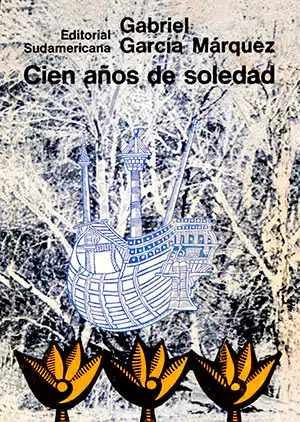Bibliographic data


Synopsis of “One Hundred Years of Solitude”
“One Hundred Years of Solitude” by Gabriel García Márquez is a masterpiece of magical realism that tells the story of the Buendía family over seven generations in the fictional town of Macondo. From its founder, José Arcadio Buendía, who dreams of a city of mirrors, to his descendants, the Buendías face tumultuous relationships, triumphs, tragedies, and supernatural revelations.
Macondo, an initially idyllic place, becomes the setting where history, politics and the fantastic intertwine. As time progresses, the town and its inhabitants experience extraordinary events, from endless rains to visits from gypsies with mysterious wonders.
Through lyrical and evocative prose, García Márquez draws the fine line between reality and magic, showing how memory, passion and fatality affect both individuals and entire generations. The story of the Buendías is a reflection on loneliness, love, memory and the inexorable passage of time. In this literary universe, the everyday and the magical coexist, revealing the joys, sorrows and enigmas of the human condition. The novel becomes a family odyssey where each character, with their dreams, fears and obsessions, contributes to the rich narrative tapestry that has made “One Hundred Years of Solitude” one of the most acclaimed works of world literature.
Spoiler Alert
Summary of “One Hundred Years of Solitude”
“One Hundred Years of Solitude” is one of the masterpieces of Latin American literature, an epic that tells the story of the Buendía family over seven generations in the fictional town of Macondo.
The narrative begins with José Arcadio Buendía, the patriarch, who decides to settle in a secluded place after having fled his hometown due to a duel. He founded Macondo with his wife, Úrsula Iguarán, and over time, the place becomes a vital center with its own dynamics, marked by the mysterious events and decisions of the Buendías.
José Arcadio and Úrsula, bound by the superstition of endogamy and fearing their offspring might bear pig tails due to their close kinship, represent the tension between progress and tradition. His descendants, including Aureliano, Arcadio, and others who share those same names, play central roles in the destinies of Macondo.
Aureliano Buendía, son of José Arcadio, becomes a revolutionary leader, representing the politics and turbulent history of Latin America. His life is marked by loneliness and sadness, recurring aspects in the novel.
Macondo, on the other hand, is not an ordinary place. It is wrapped in magical realism, where the extraordinary happens as something everyday: showers of yellow flowers, ascensions to heaven, prophecies, and curses. It is in this environment where stormy loves develop, such as that between Mauricio Babilonia and Renata Remedios, who suffers the condemnation of Fernanda del Carpio and the overprotection of Úrsula.
Another emblematic character is Melquíades, the gypsy who introduces to Macondo the magnet, the mirrors, the ice, and, finally, some scrolls that record the history of the Buendía family, sealing their destiny. These scrolls, indecipherable at first, are the key to the story’s outcome.
As generations pass, the family faces various challenges, from American intervention in the region to the massacre of workers on a banana plantation, which reflects the exploitation and violence in Latin American history.
As the story progresses, the Buendías fall into a repetitive cycle of passions, mistakes, and misfortunes, marked by names and personalities that repeat themselves in a circular pattern. The boundaries between past, present, and future blur, and Melquíades’ prophecies about the race condemned to a hundred years of solitude become more tangible.
Despite Macondo’s initial prosperity, the city begins to decline for various reasons, including the arrival of foreign companies and the devastating consequences of civil wars. The last Buendía, who bears the ominous name of Aureliano, faces the final loneliness of his lineage as he deciphers the scrolls of Melquíades. The revelation is clear: the history of the Buendías was predestined from the beginning and was doomed to end in desolation.
The book concludes with the disappearance of Macondo after a devastating windstorm, symbolizing the transience and fragility of human existence and, in particular, that of the Buendía family.
“One Hundred Years of Solitude” is a deep reflection on history, love, loneliness, memory, and destiny. García Márquez interweaves the personal history of a family with the collective history of Latin America, offering a magical yet painfully real vision of humanity. Through this work, Gabriel García Márquez not only established his place as one of the great storytellers of the 20th century but also cemented magical realism’s reputation as one of the most original and captivating forms of modern literature.
Key Characters in “One Hundred Years of Solitude”
José Arcadio Buendía: José Arcadio Buendía is the founding patriarch of the town of Macondo and the Buendía family. Physically robust and with indomitable energy, he is a man of vision and dreams, marked by his insatiable curiosity and his tendency to obsess over various inventions and discoveries.
After a conflict in his hometown that results in the death of Prudencio Aguilar, and tormented by the ghost of the deceased, he decides to embark on a journey with his family, founding Macondo on the banks of a river. During his leadership, Macondo is a kind of Eden, isolated from the outside world. However, his obsession with alchemy and the search for the city of gold eventually leads him to seclusion and madness.
He is married to his cousin Úrsula Iguarán. Together they have three children: José Arcadio (son), Aureliano and Amaranta. His relationship with Melquíades, the gypsy, is fundamental to his development. Through him, José Arcadio enters the world of alchemy and science.
Úrsula Iguarán: Úrsula is the resilient matriarch of the Buendía family. Her greatest initial fear was that of inbreeding, since she and her husband are cousins. This fear manifests itself in her constant worry that her descendants will be born with a pig’s tail, a family superstition. Despite her continuous challenges and tragedies, Úrsula lives for more than a hundred years, becoming a witness and backbone of multiple generations of Buendías and Macondo itself.
Her relationship with José Arcadio Buendía is complex. Although she is often exasperated by his obsessions, she also loves him deeply and strives to maintain family stability. She is the mother of José Arcadio (son), Aureliano and Amaranta, and grandmother of Remedios la Bella, among others.
Aureliano Buendía: Aureliano Buendía is the second son of Úrsula and José Arcadio Buendía. With a contrasting personality to that of his brother, Aureliano is introspective, solitary and often immersed in deep reflections. His figure is central to the novel, not only because of his actions, but also because of the recurrence of the name “Aureliano” in later generations.
From a young age, Aureliano shows a deep interest in the teachings of Melquíades, which leads him to be immersed in alchemy and attempts to decipher the gypsy’s scrolls. However, his life takes a drastic turn when he joins the liberal cause in the civil war that the country is going through. As a revolutionary leader he fights fervently for his ideals, although over time he begins to question the nature and purpose of war. After multiple battles, he signs a peace treaty that, paradoxically, turns out to be more destructive to his cause.
His love life is tumultuous. He never consummates his love with Remedios, who dies young. He eventually locks himself in Melquíades’ workshop, where he dedicates himself to casting gold fish until his death.
He respects his parents, José Arcadio Buendía and Úrsula, but remains distant due to his introspective nature. He maintains a special relationship with Melquíades, who introduces him to the world of alchemy and the secrets of life and death. His infatuation with Remedios marks him deeply, and his relationship with his children Aurelianos highlights his disconnection from fatherhood and the family’s tragic destiny.
José Arcadio (son): First son of Úrsula and José Arcadio Buendía. He is impulsive, strong, and passionate. Unlike his brother Aureliano, José Arcadio is extroverted and is characterized by his carnal desires and his temper.
Remedios La Bella: Granddaughter of Úrsula and José Arcadio Buendía. She is considered the most beautiful woman in Macondo and, despite her extraordinary beauty, she is innocent and carefree. Her mysterious disappearance, ascending to heaven, is one of the most emblematic episodes of magical realism in the novel.
Aureliano Segundo: Son of Arcadio and Santa Sofía de la Piedad. His stormy relationship with Petra Cotes plays a central role in the plot.
Fernanda del Carpio: Wife of Aureliano Segundo. She comes from a declining aristocratic family. She is haughty, proud, and obsessed with appearances. It represents the contrast between the old aristocracy and the chaos of the Buendías.
Renata Remedios (Meme): Daughter of Fernanda and Aureliano Segundo. She is sent to the convent by her mother after her mother discovers her relationship with Mauricio Babilonia.
Aureliano Babilonia (Aureliano II): Son of Meme, is the last of the Buendía line. It is he who deciphers the scrolls of Melquíades, understanding the predestination and condemnation of his family.
Melquíades: The gypsy Melquíades is a character shrouded in mystery and wisdom. Elderly and with knowledge that seems to transcend time, he represents Macondo’s connection to the outside world and the supernatural. He is the author of the encrypted scrolls that contain the history and destiny of the Buendía family. His friendship with José Arcadio Buendía is central to the story. Through this relationship, Melquíades introduces magical realism and alchemy into Buendía’s life. He also has a special bond with the young Aureliano, whom he initiates into the task of deciphering the scrolls.
Mauricio Babilonia: Lover of Meme. He is known for being constantly surrounded by yellow butterflies. His life changes drastically after being paralyzed by a shot ordered by Fernanda del Carpio.
Petra Cotes: Lover of Aureliano Segundo. She is characterized by her passion. Her relationship with Aureliano Segundo brings prosperity to both animals and land.
Analysis of “One Hundred Years of Solitude”
“One Hundred Years of Solitude” is considered not only one of the most outstanding works of Gabriel García Márquez, but also a fundamental pillar of world literature of the 20th century. This novel, published in 1967, solidified García Márquez’s reputation as one of the most important contemporary writers and opened the doors for the world to discover the literary wealth of Latin America.
Importance within the author’s work:
Although García Márquez had already gained recognition with his stories and his novel “La Hojarasca”, it was “One Hundred Years of Solitude” that catapulted his fame to international levels. The book became a defining work of the “Latin American Boom,” a literary movement that introduced the world to the region’s innovative narratives. This novel, due to its thematic and stylistic vastness, encapsulates many of the themes and styles that the author would address throughout his career.
Narrative style:
The style of “One Hundred Years of Solitude” was revolutionary. García Márquez combines lyrical, detailed prose with a narrative structure that defies the conventions of time and space. The story does not follow a clear timeline, characters are born and die, and then resurrected or reincarnated, and the fate of the Buendía family is told in a tone that mixes the historical with the mythical.
Magical realism:
This style, although not originated by García Márquez, reaches its maximum expression in this novel. Magical realism allows the extraordinary to coexist with the mundane. Through this fusion, the author explores the tension between reality and fantasy. Supernatural situations—such as the rain of yellow flowers or the ascension of Remedios the Beautiful—are not questioned, but accepted as part of the reality of Macondo. These magical elements serve to highlight the wonder and mystery inherent in the human experience and, in particular, in the history of Latin America.
Historical context:
García Márquez weaves the fictional history of Macondo in parallel with the real history of Colombia and, in general, Latin America. Events such as the Banana Massacre, where an American fruit company and the Colombian government violently repressed a strike, are reflected in the narrative. These historical episodes, although adapted to the universe of Macondo, highlight the political, economic, and social tensions that have shaped the region.
Main themes:
The novel addresses multiple themes, from love and passion to war, politics, and the inexorable passage of time. Endogamy and fear of incest, symbolized by the myth of the Buendía children being born with pig tails, highlight Macondo’s isolation and its resistance to change.
Loneliness and sadness:
The title of the work already points to loneliness as a central theme. Each member of the Buendía family faces, at some point, deep loneliness, whether due to their decisions, their passions, or their destiny. This loneliness reflects the human condition, the isolation inherent in existence, and the search for connection. Sadness, for its part, manifests itself in the cyclical repetition of tragedies that affect the family throughout generations.
Reception and influence:
“One Hundred Years of Solitude” was acclaimed upon its publication. It quickly sold thousands of copies and was translated into multiple languages, establishing itself as a masterpiece of universal literature. Its influence is palpable not only in later writers but also in other artistic forms such as cinema, music, and the visual arts. It is a novel that transcends its original context, offering a deep and magical vision of the human condition.
In conclusion, “One Hundred Years of Solitude” is a rich and complex work that challenges narrative conventions and offers a unique vision of Latin American history and culture. Through magical realism and his poetic prose, García Márquez invites the reader on a journey through time, memory, and loneliness, exploring with sensitivity and acuity the joys, tragedies, and enigmas of human existence.


